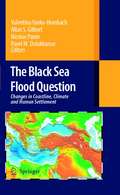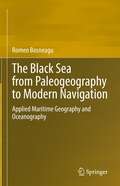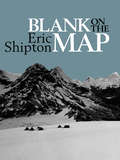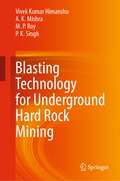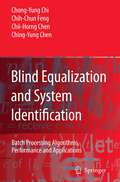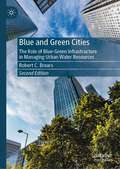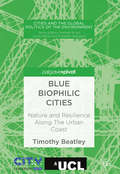- Table View
- List View
Black Objects in Supergravity: Proceedings of the INFN-Laboratori Nazionali di Frascati School 2011 (Springer Proceedings in Physics #144)
by Stefano BellucciThis is the sixth volume in a series of books on the general topics of supersymmetry, supergravity, black holes and the attractor mechanism. The present volume is based upon lectures held in May 2011 at the INFN-Laboratori Nazionali di Frascati School on Black Objects in Supergravity (BOSS2011), directed by Stefano Bellucci, with the participation of prestigious lecturers, including G. Lopes Cardoso, W. Chemissany, T. Ortin, J. Perz, O. Vaughan, D. Turton, L. Lusanna and S. Ferrara. All lectures were at a pedagogical, introductory level, a feature which is reflected in the specific "flavor" of this volume, which also benefited greatly from extensive discussions and related reworking of the various contributions.
The Black Sea: Physical, Environmental and Historical Perspectives (Springer Geography)
by Emil Vespremeanu Mariana GolumbeanuThis book underpins the geography of the Black Sea, covering topics such as morphology, morphography, geology, and history of the Black Sea. It also discusses environmental aspects affecting the population in the Black Sea's coastal settlements and looks to the future of the Black Sea region. This book covers a gap in research in the field of world regional geography of the Black Sea by providing a comprehensive methodology and terminology to readers, students and teachers in the field.
The Black Sea Encyclopedia (Encyclopedia of Seas)
by Sergei R. Grinevetsky Igor S. Zonn Sergei S. Zhiltsov Aleksey N. Kosarev Andrey G. KostianoyThis publication is devoted to the natural feature – the Black Sea and its littoral states. At the same time the Azov Sea is also considered here. This region is the focus of many geopolitical, economic, social and environmental issues that involve not only the countries coming out to the Black and Azov Seas, but other world countries, too.This publication contains over 1500 articles and terms providing descriptions of geographical and oceanographic features, cities, ports, transport routes, marine biological resources, international treaties, national and international programs, research institutions, historical and archaeological monuments, activities of prominent scientists, researchers, travelers, military commanders, etc. who had relation to the Black Sea.It includes a multi-century chronology of the events that became the outstanding milestones in the history of development of the Black Sea – Azov Sea region.
The Black Sea Environment (The Handbook of Environmental Chemistry #5 / 5Q)
by Aleksey N. KosarevBased on a wealth of primary data collected by expeditions as well as archive data from Russia, this fascinating book features a systematic description of the knowledge accumulated on the physical oceanography, marine chemistry and pollution, marine biology and geology, meteorology and hydrology of the Black Sea. It presents the principal characteristic features of the environmental conditions of the sea and their changes in the second half of the 20th century.
The Black Sea Flood Question: Changes in Coastline, Climate and Human Settlement
by Valentina Yanko-Hombach Allan S. Gilbert Nicolae Panin Pavel M. DolukhanovThis book brings together eastern and western scholarship on a controversial subject: a catastrophic inundation of the Pontic basin which might have inspired the biblical story of Noah’s flood. In 35 papers, many previously unavailable in English, experts in oceanography, marine geology, paleoclimate, paleoenvironment, archaeology, and linguistic spread offer data and arguments for or against the flood hypothesis. Appendices include 600 radiocarbon dates from the region, obtained by USSR and western labs.
The Black Sea from Paleogeography to Modern Navigation: Applied Maritime Geography and Oceanography
by Romeo BosneaguThis book provides an analysis of the evolution of navigation and seaborne trade in the Black Sea, considering the geographic, geological, and hydro-meteorological data, including information from the historical, geopolitical, economic, social, and military frames. In ancient times the Black Sea was at the edge of the known world, and together with its coasts it preserves traces of the Greek, Roman, and Byzantine civilizations. Many of the ancient ports were important and essential towns, which remains the case in modern times. The complex geographical conditions that have historically influenced, and continue to influence the development of maritime trade and transport in the Black Sea, have not been thoroughly researched or optimized for these activities. The book is divided into ten chapters. Chapter I describes the physical – geographical conditions of the Black Sea’s basin, and the geological evolution of its recent history, with application to the hypothesis of Noah's flood. Chapter 2 presents a short history of the research conducted on the Black Sea upto present day. Chapter 3 summarizes the specific characteristics of the Black Sea’s morphohydrography and morphodynamics. Chapter 4 contains the conclusions regarding the influence of coastal relief on the navigation and seaborne trade on the Black Sea. Chapter 5 analyzes the Black Sea basin’s meteo-climatic regime. Chapter 6 contains the conclusions of the influence of weather and climate factors on the navigation and seaborne trade on the Black Sea. Chapter 7 describes the specific hydrological factors of the Black Sea. Chapter 8 contains the conclusions regarding the influence of the hydrological factors for the navigation and seaborne trade on the Black Sea. Chapter 9 presents the Black Sea’s specific hydrobiological elements specific, as a „unicum hydrobiologicum”, and the main features of the Black Sea’s ecology. Chapter 10 is concentrated on the historical, social, political, economic, and geopolitical framework of the Black Sea basin influencing navigation and maritime transportation, from ancient times to the present. The book is written from the perspective of a Romanian Navy officer, with more than 40 years’ experience in the Romanian Navy
Black Sea Oceanography (Nato Science Series C: #351)
by E. Izdar James W. MurrayProceedings of the NATO Advanced Research Workshop, Çesme, Izmir, Turkey, October 23-27, 1989
Bladder wrack (large print)
by RnibThis is an image of the brown bladder wrack seaweed: Fucus vesiculosis.There is a locator dot shown, which will be at the top left of the page when the image is the correct way up.The plant is part of the algae family. It fills most of the page and is anchored to the seabed at the bottom of the page. From here it branches out into five flat lamina or blades with wavy edges. It has a thick midrib along the blades with oval-shaped air bladders to either side.At the ends of the blades, in the top part of the image, are heart-shaped structures called receptacles. These are the plans reproductive organs. They look very similar in both the male and female plants.The bladder wrack is found along the coastlines of the north and south Atlantic. It grows up to one metre in length.
Bladder wrack (UEB contracted)
by RnibThis is an image of the brown bladder wrack seaweed: Fucus vesiculosis.There is a locator dot shown, which will be at the top left of the page when the image is the correct way up.The plant is part of the algae family. It fills most of the page and is anchored to the seabed at the bottom of the page. From here it branches out into five flat lamina or blades with wavy edges. It has a thick midrib along the blades with oval-shaped air bladders to either side.At the ends of the blades, in the top part of the image, are heart-shaped structures called receptacles. These are the plans reproductive organs. They look very similar in both the male and female plants.The bladder wrack is found along the coastlines of the north and south Atlantic. It grows up to one metre in length.
Bladder wrack (UEB uncontracted)
by RnibThis is an image of the brown bladder wrack seaweed: Fucus vesiculosis.There is a locator dot shown, which will be at the top left of the page when the image is the correct way up.The plant is part of the algae family. It fills most of the page and is anchored to the seabed at the bottom of the page. From here it branches out into five flat lamina or blades with wavy edges. It has a thick midrib along the blades with oval-shaped air bladders to either side.At the ends of the blades, in the top part of the image, are heart-shaped structures called receptacles. These are the plans reproductive organs. They look very similar in both the male and female plants.The bladder wrack is found along the coastlines of the north and south Atlantic. It grows up to one metre in length.
Blank on the Map: Pioneering exploration in the Shaksgam valley and Karakoram mountains.
by Eric Shipton'As I studied the maps, one thing about them captured my imagination … Across this blank space was written one challenging word, "Unexplored"' In 1937 two of the twentieth century's greatest explorers set off to explore an unknown area of the Himalaya, the breath-taking Shaksgam mountains. With a team of surveyors and Sherpas, Eric Shipton and H.W. Tilman located and mapped the land around K2, the second-highest mountain in the world. It was their greatest venture, and one that paved the way for all future mountaineering in that area of the Himalaya. For Shipton and Tilman, exploration was everything, with a summit a welcome bonus, and Blank on the Map is the book that best captures their spirit of adventure. With an observant eye and keen sense of humour, Shipton tells how the expedition entered the unknown Shaksgam mountains, crossing impenetrable gorges, huge rivers and endless snow fields. There's a very human element to in Shipton's dealings with his Sherpa friends, and with his Balti porters, some of whom were helpful, while some were less so. The expedition uncovers traces of ancient cultures and visits vibrant modern civilisations living during the last days of the British Empire. Only when all supplies are exhausted, their clothes in tatters and all equipment lost do the men finally return home. A mountain exploration classic.
Blasting Technology for Underground Hard Rock Mining
by Vivek Kumar Himanshu A. K. Mishra M. P. Roy P. K. SinghThis book presents the principles and practices of rock blasting for underground hard rock mining. It covers a theoretical background of the rock blasting technology and comprehensive case studies on different stages of rock blasting for underground metalliferous mining. It includes the discussions on burn-cut face blasting pattern, slot raise excavation methodology, and ring blasting methods. It further discusses different practical challenges associated with underground blasting, viz. ore dilution, ground vibration, wall instability, etc., and their possible solutions. The book also covers the recent advancements in methodologies to predict blasting outcomes and instrumentations for monitoring rock blasting operations. The book is a useful reference for rock blasting practitioners, mining engineers, professionals, and researchers. It is also a valuable reference for undergraduate and postgraduate students.
Bleakonomics: A Heartwarming Introduction to Financial Catastrophe, the Jobs Crisis and Environmental Destruction
by Rob LarsonThis is a darkly humorous guide to the three great crises plaguing today's world: environmental degradation, social conflict in the age of austerity and financial instability.*BR**BR*Rob Larson holds mainstream economic theory up against the grim reality of a planet in meltdown. He looks at scientists’ conclusions about climate change, the business world’s opinions about its own power, and reveals the fingerprints of finance on American elections.*BR**BR*Through ascerbic analysis, Bleakonomics unveils a world of extreme inequality, confusion and insanity.*BR**BR*
Bleakonomics: A Heartwarming Introduction to Financial Catastrophe, the Jobs Crisis and Environmental Destruction
by Rob LarsonThis is a darkly humorous guide to the three great crises plaguing today's world: environmental degradation, social conflict in the age of austerity and financial instability.*BR**BR*Rob Larson holds mainstream economic theory up against the grim reality of a planet in meltdown. He looks at scientists’ conclusions about climate change, the business world’s opinions about its own power, and reveals the fingerprints of finance on American elections.*BR**BR*Through ascerbic analysis, Bleakonomics unveils a world of extreme inequality, confusion and insanity.*BR**BR*
Blind Equalization and System Identification: Batch Processing Algorithms, Performance and Applications
by Chong-Yung Chi Chih-Chun Feng Chii-Horng Chen Ching-Yung ChenThe absence of training signals from many kinds of transmission necessitates the widespread use of blind equalization and system identification. There have been many algorithms developed for these purposes, working with one- or two-dimensional signals and with single-input single-output or multiple-input multiple-output, real or complex systems. It is now time for a unified treatment of this subject, pointing out the common characteristics of these algorithms as well as learning from their different perspectives. "Blind Equalization and System Identification" provides such a unified treatment presenting theory, performance analysis, simulation, implementation and applications. This is a textbook for graduate courses in discrete-time random processes, statistical signal processing, and blind equalization and system identification. It contains material which will also interest researchers and engineers working in digital communications, source separation, speech processing, and other, similar applications.
Blockchain: Transforming Your Business and Our World
by Mark Van Rijmenam Philippa RyanThe internet was envisaged as a decentralised global network, but in the past 25 years it has come to be controlled by a few, very powerful, centralised companies. Blockchain is a technological paradigm shift that allows secure, reliable, and direct information transfer between individuals, organisations, and things, so that we can manage, verify, and control the use of our own data. Blockchain also offers a new opportunity for humanity to fix some major problems. It can authenticate data, manage its analysis, and automate its use. With better data comes better decision-making. In this way, Blockchain can contribute to solving climate change, reduce voting fraud, fix our identity systems, improve fair trade, and give the poor an opportunity to improve their lives by monetising their (digital) capital. A world built upon peer-to-peer transactions and smart contracts can empower individuals and communities. This book offers a fresh perspective with which to consider this transformative technology. It describes how Blockchain can optimise the processes that run our society. It provides practical solutions to global problems and offers a roadmap to incorporate Blockchain in your business. It offers a blueprint for a better world. Filled with easy-to-understand examples, this book shows how Blockchain can take over where the internet has fallen short.
Blockchain: Transforming Your Business and Our World
by Mark Van Rijmenam Philippa RyanThe internet was envisaged as a decentralised global network, but in the past 25 years it has come to be controlled by a few, very powerful, centralised companies. Blockchain is a technological paradigm shift that allows secure, reliable, and direct information transfer between individuals, organisations, and things, so that we can manage, verify, and control the use of our own data. Blockchain also offers a new opportunity for humanity to fix some major problems. It can authenticate data, manage its analysis, and automate its use. With better data comes better decision-making. In this way, Blockchain can contribute to solving climate change, reduce voting fraud, fix our identity systems, improve fair trade, and give the poor an opportunity to improve their lives by monetising their (digital) capital. A world built upon peer-to-peer transactions and smart contracts can empower individuals and communities. This book offers a fresh perspective with which to consider this transformative technology. It describes how Blockchain can optimise the processes that run our society. It provides practical solutions to global problems and offers a roadmap to incorporate Blockchain in your business. It offers a blueprint for a better world. Filled with easy-to-understand examples, this book shows how Blockchain can take over where the internet has fallen short.
Blockchain for Business: A Practical Guide for the Next Frontier
by Yannis KalfoglouThis book sets out to explain blockchain for the non-technical expert, to decipher the dense technicalities that dominate the field and to present the opportunities for busy professionals using practical applications and case studies. Presented in a clear and structured way and with documented real-world cases, the book is a practical reference guide that can be used across different industries. It offers both a constructive and critical review of the pain points blockchain is facing today, illustrates the pitfalls as well as the opportunities for business and describes the steps towards overcoming them. It also aims to provide a unique view of both the intersection and synergy of blockchain with other emerging technologies and the wider digital ecosystem, as we see increasingly that blockchain alone won’t be able to deliver business solutions. Most important, the book identifies trends and a path for the future of blockchain and its impact on society as a whole. The book is written for business audiences across all sectors. It is not a technical guide to blockchain, but it enables businesspeople to be better informed and prepared to plan ahead and develop strategies using blockchain.
Blockchain for Business: A Practical Guide for the Next Frontier
by Yannis KalfoglouThis book sets out to explain blockchain for the non-technical expert, to decipher the dense technicalities that dominate the field and to present the opportunities for busy professionals using practical applications and case studies. Presented in a clear and structured way and with documented real-world cases, the book is a practical reference guide that can be used across different industries. It offers both a constructive and critical review of the pain points blockchain is facing today, illustrates the pitfalls as well as the opportunities for business and describes the steps towards overcoming them. It also aims to provide a unique view of both the intersection and synergy of blockchain with other emerging technologies and the wider digital ecosystem, as we see increasingly that blockchain alone won’t be able to deliver business solutions. Most important, the book identifies trends and a path for the future of blockchain and its impact on society as a whole. The book is written for business audiences across all sectors. It is not a technical guide to blockchain, but it enables businesspeople to be better informed and prepared to plan ahead and develop strategies using blockchain.
Blockchain Technologies in the Textile and Fashion Industry (Textile Science and Clothing Technology)
by Subramanian Senthilkannan MuthuThis book presents applications of blockchain technologies to foster sustainable development in the textile and clothing supply chain. The concept of Textiles and Fashion Sustainability has grown to a wider extent today. Among the list of items to achieve Sustainability in Textiles and Fashion, the key element is the traceability of supply chains in terms of mapping and tracing the entire supply chain to ensure sustainable supply chain management. Reliable and transparent, efficient data is one of the crucial requirements for Textiles and Fashion Sustainability in today’s advanced industrial context and this is possible in this advanced era by various technological advancements such as Block chain technologies. These days one can see a widespread application of blockchain technology in the Textiles and Clothing sector. The core competencies of blockchain technology namely transparency, data auditability, privacy, value transfer, and process efficiency and automation are very much essential for achieving the multifold objectives under the theme Textiles and Fashion Sustainability.
Blöcke und Kokillen
by A.W. Brearley H. Brearley F. RapatzDieser Buchtitel ist Teil des Digitalisierungsprojekts Springer Book Archives mit Publikationen, die seit den Anfängen des Verlags von 1842 erschienen sind. Der Verlag stellt mit diesem Archiv Quellen für die historische wie auch die disziplingeschichtliche Forschung zur Verfügung, die jeweils im historischen Kontext betrachtet werden müssen. Dieser Titel erschien in der Zeit vor 1945 und wird daher in seiner zeittypischen politisch-ideologischen Ausrichtung vom Verlag nicht beworben.
Blue: In Search of Nature's Rarest Color
by Kai KupferschmidtAn adventure story tracing the mystery of our planet&’s beauty in three parts: a quest to find blue—one of the rarest of colors in nature—out in the natural world among minerals, animals, and plants; a compelling meditation on blue&’s impact on our culture, language, and the author&’s own life; and a fascinating look at the science behind how this rare wavelength of light works
Blue and Green Cities: The Role Of Blue-green Infrastructure In Managing Urban Water Resources
by Robert C. BrearsThis book offers new research on urban policy innovations that promote the application of blue-green infrastructure in managing water resources sustainably. The author argues that urban water managers have traditionally relied on grey infrastructural solutions to mitigate risks with numerous economic and environmental consequences. Brears explores the role urban water managers have in implementing blue-green infrastructure to reduce ecological damage and mitigate risk. The case studies in this book illustrate how cities, of differing climates, lifestyles and income-levels, have implemented policy innovations that promote the application of blue-green infrastructure in managing water, wastewater and stormwater sustainably to reduce environmental degradation and enhance resilience to climate change. This new research on urban policy innovations that promote the application of blue-green infrastructure in managing water resources sustainably will be of interest to those working on water conservation and policy.
Blue and Green Cities: The Role of Blue-Green Infrastructure in Managing Urban Water Resources
by Robert C. BrearsA completely revised and updated new edition of this successful book focused on urban policy innovations that promote the application of blue-green infrastructure in managing water resources sustainably. Since the first edition published, nature-based solutions in general and blue-green infrastructure, in particular, have become a more recognised solution to various societal challenges, including mitigating climatic extremes in cities while restoring the natural environment and enhancing biodiversity. This new edition provides updated research on urban policy innovations that promote the application of BGI in managing water resources sustainably. In particular, the book contains case studies that illustrate how cities of differing climates, lifestyles and income levels have implemented policy innovations that promote the application of BGI in managing water, wastewater and stormwater sustainably to enhance resilience to climate change and reduce environmental degradation. The seven case studies are leading cities that have implemented various fiscal and non-fiscal policy tools to encourage the implementation of BGI on both public and private property to reduce stormwater runoff volumes, enhance the health of waterways, enhance resilience to climate change and meet regulatory requirements.
Blue Biophilic Cities: Nature and Resilience Along The Urban Coast
by Timothy BeatleyThere is a growing recognition of the contact we need with nature to be happy, healthy and to lead meaningful lives. We need that nature daily, if not hourly, and so it must be nearby to where we live and work. This is central to the concept of ‘biophilic cities’ which is emerging as a global movement and guiding framework for city design and planning. Blue Biophilic Cities is about the promise of this movement and a kind of biophilic urbanism that is possible for cities perched on the edge of harbours and seas. In blue biophilic cities, much of the nearby nature is to be found in the marine realm. This book explores the efforts underway in a number of cities to foster new marine connections through a variety of innovative programs and initiatives. It also discusses a number of design ideas, from dynamic shoreline edges and floodable parks to living breakwaters, in order to emphasise the possibility of designing for resilience while also supporting marine biodiversity and strengthening biophilic connections to the marine world.




